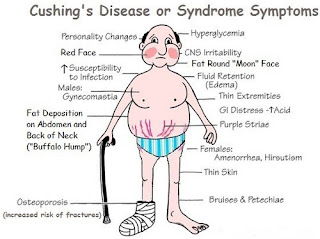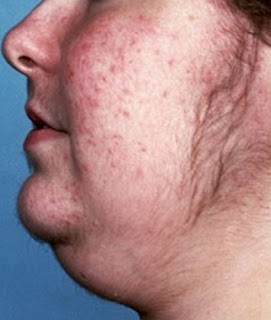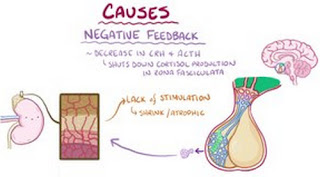What is Cushing syndrome?
A Cushing syndrome is a group of symptoms that develop as a result of an extremely high cortisol level in the body. Hence, the condition is also called hypercortisolism. There are a variety of reasons why the level of cortisol goes out of control. (1, 2, and 3)
picture 1: A typical image of a person with a Cushing syndrome.
image source: mayoclinic.org
picture 2: The classic signs and symptoms of Cushing syndrome.
image source: bloglino.com
picture 3: A person with a Cushing syndrome.
image source: syndromepictures.com
picture 4: Images differentiating a normal person and a person with a Cushing syndrome.
image source: myhealthyfeeling.com
image source: myhealthyfeeling.com
picture 5: A transformation image of a person with a Cushing syndrome.
image source: insidetheclinic.com
image source: insidetheclinic.com
Cushing syndrome symptoms
The symptoms vary from one person to another. Some people have mild symptoms like an irregular menstrual period and weight gain. On the other hand, those with severe symptoms experience weight gain, especially in the trunk area, high blood pressure, mood swing, memory lapses, excessive hair growth in women, easy irritability, and difficulty concentrating. (3, 4, and 5)Cushing syndrome causes
The adrenal gland is the one producing the hormone cortisol. A normal level of cortisol in the body helps regulate a healthy vascular system, strengthen the body's ability to cope with stress, balances the effect of insulin, helps convert carbohydrates into energy, and improve the body's inflammatory response. However, an extremely high level of cortisol could cause an imbalance to the normal functions of the body. Causes of high cortisol level include the following:- malnutrition
- exposure to a high level of stress such as surgery-related stress, emotional stress, physical stress, and mental stress.
- excessive intake of alcohol (2)
- use of corticosteroid medications
- tumor in the pituitary gland
- familial Cushing syndrome (3)
Cushing syndrome vs Cushing disease
A Cushing syndrome is different from a Cushing disease. The former pertains to the collection of symptoms linked with the excess level of cortisol in the body. The latter is a disease condition caused by a tumor in the pituitary gland leading to over secretion of hormone ACTH. (5, 6, and 7)
picture 6: Some of the causes of Cushing syndrome.
image source: upload.wikimedia.org
picture 7: A typical characteristic of a woman with a Cushing syndrome.
image source: cushieblog.files.wordpress.com
image source: cushieblog.files.wordpress.com
picture 8: A woman with excessive hair growth, which is one of the symptoms of Cushing syndrome.
image source: jeffreysterlingmd.files.wordpress.com
image source: jeffreysterlingmd.files.wordpress.com
Cushing syndrome diagnosis
How is Cushing syndrome diagnosed? The diagnosis is made based on the level of cortisol in the body. Laboratory testing and blood works should be done to come up with the most accurate diagnosis. Some of the diagnostic procedures include:- A 24-hour urinary free cortisol test (8)
- low dose dexamethasone suppression test/high dose dexamethasone suppression test
- midnight plasma cortisol measurement
- late night salivary cortisol measurement
- corticotropin-releasing hormone stimulation test
- CT scan
- MRI scan (7)
Cushing's syndrome treatment
What are the available treatments for Cushing syndrome? The treatment approach primarily depends on the cause. Doctors usually prescribe drugs that can significantly decrease the production of cortisol and another drug that helps block the effect of excess cortisol in the body. If the Cushing syndrome is caused by a tumor, it should be removed surgically. If the tumor is malignant, the best course of action includes radiation therapy and chemotherapy. A person with a Cushing syndrome is strongly advised to be selective in the foods he/she eats. Cushing syndrome diet includes eating foods high in calcium and protein and low in calorie. (8, 9, and 10)What are the possible complications?
Cushing syndrome should be treated right away to prevent serious and irreversible complications. Some of the possible complications include muscle loss, bone fracture and bone loss, susceptibility to infection, type 2 diabetes mellitus, a possibility of kidney stones, high blood pressure, and enlargement of tumor in the pituitary gland. (5, 10)References
- https://www.mayoclinic.org/diseases-conditions/cushing-syndrome/symptoms-causes/syc-20351310
- https://en.wikipedia.org/wiki/Cushing%27s_syndrome
- https://medlineplus.gov/ency/article/000410.htm
- https://www.healthline.com/health/cushing-syndrome
- https://www.nhs.uk/conditions/cushings-syndrome/
- https://www.pituitarysociety.org/patient-education/pituitary-disorders/cushings/diagnosis-of-cushings-disease-and-cushings-syndrome
- https://pituitary.org/knowledge-base/disorders/cushing-s-syndrome
- https://www.webmd.com/a-to-z-guides/cushing-syndrome#1
- https://www.niddk.nih.gov/health-information/endocrine-diseases/cushings-syndrome
- https://www.medicinenet.com/cushings_syndrome/article.htm









